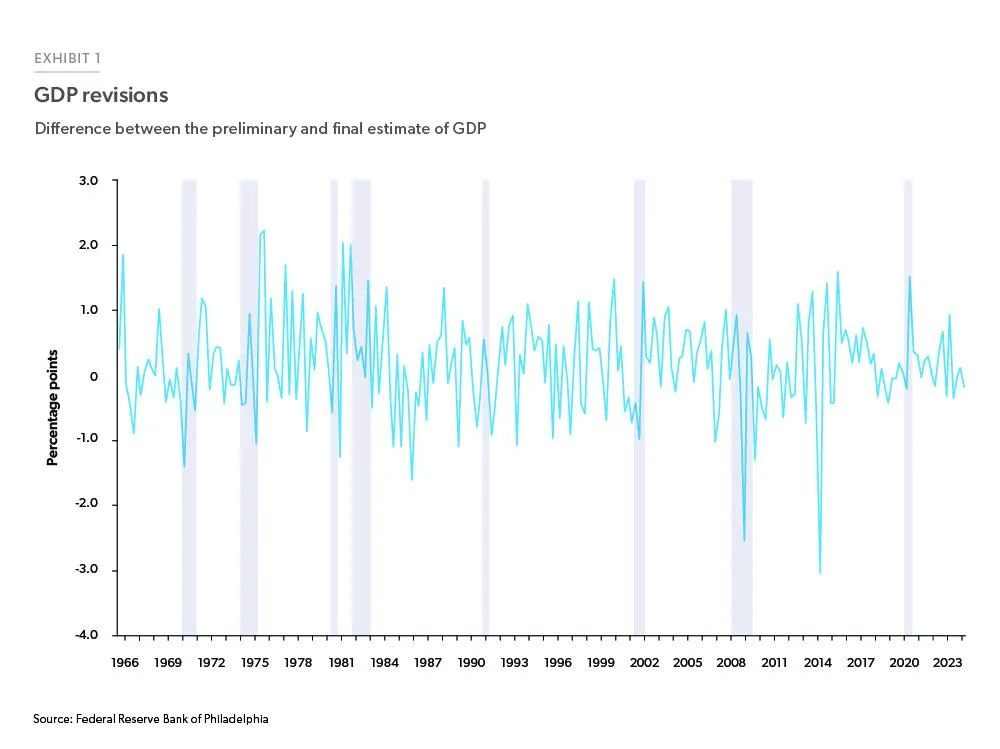
The U.S. economy showed signs of deceleration in Q1 2024, with growth slowing to its lowest rate since Q2 2022. While the labor market is still resilient, key indicators suggest a gradual cooling, as home sales remain sluggish despite slightly lower mortgage rates. Inventory levels have improved but continue to trail pre-pandemic norms.
Credit card and auto loan performance has deteriorated compared to pre-pandemic levels, though mortgage loans have shown greater resilience. Notably, consumers with mortgages are managing non-mortgage credit better than those without.
The Bureau of Economic Analysis (BEA) released its third estimate of U.S. GDP growth for Q1 2024, showing a slight improvement to a 1.4% annualized rate, up from the second estimate of 1.3%. The revision was driven by reduced imports and increased nonresidential investment and government spending. However, consumer spending growth slowed from 2.0% to 1.5%, contributing less to GDP than initially estimated.
Gross Domestic Income (GDI) rose by 1.3% during the quarter, while the average of GDP and GDI—a balanced measure of economic activity—also increased by 1.4%. The final GDP estimate came in slightly below the initial forecast, with an 18-basis point reduction. Historically, revisions in GDP estimates have averaged around 17 basis points since 1965, with downward revisions typically occurring at the start of recessions. However, during the pandemic recession of 2020, the GDP estimate was revised upward due to a surge in activity as restrictions were eased.

The June employment report from the Bureau of Labor Statistics (BLS) showed a total of 206,000 new jobs added, while revisions for April and May resulted in a downward adjustment of 111,000 jobs. Most job gains were concentrated in healthcare, social assistance, and government sectors. While job growth for 2024 stands at 1.3 million so far, the unemployment rate has climbed to 4.1%, the highest since November 2021.
Job openings rose slightly to 8.1 million in May, but April's total was revised down to the lowest level since March 2021. The job openings-to-unemployed ratio, an important indicator of labor market health, dropped to its lowest since June 2021, signaling a gradual loosening of labor demand.
On the inflation front, the core Personal Consumption Expenditure (PCE) Price Index, the Federal Reserve's preferred inflation gauge, rose by just 0.1% month-over-month and 2.6% year-over-year in May, marking the lowest annual increase since early 2021. Goods prices, particularly for gasoline and recreational items, fell during the month, while service prices—including healthcare and housing—rose modestly.
Despite the slow pace of economic growth, inflation appears to be easing, and the Federal Reserve may implement only one rate cut later this year. However, interest rates are expected to remain elevated, affecting consumer delinquencies, particularly in the auto and credit card sectors.
The housing market continued to face challenges in May, as total home sales (existing and new) fell by 2.3% month-over-month to 4.7 million. Both existing and new home sales saw declines, reversing the trend of recent months where new home sales had partially offset declining existing home transactions. Inventory levels have improved slightly but are still below pre-pandemic averages, and homebuilder confidence dipped to a concerning low of 43 in June.
Housing starts also dropped in May, with a 5.5% decline in total new residential construction, as higher mortgage rates and rising construction costs weighed on the market. The average 30-year fixed mortgage rate stood at 6.92% in June, slightly below its May levels, offering limited relief to prospective buyers.
Looking ahead, we expect economic growth to remain sluggish as high interest rates continue to weigh on consumer spending and business investment. The labor market, while still healthy by historical standards, is likely to weaken further in 2024 and 2025, contributing to a further cooling of inflation. A rate cut by the Federal Reserve in late 2024 could offer some respite, especially in the housing market, where mortgage rates might ease slightly.
However, significant headwinds remain for the housing market, with affordability challenges driven by high home prices and limited inventory. While we expect mortgage rates to fall below 6.5% in 2025, home sales will likely remain subdued until then.
In terms of consumer credit, we anticipate continued stress in the auto and credit card sectors, particularly for borrowers without mortgages. By contrast, mortgage borrowers have shown greater resilience, with delinquency rates remaining below pre-pandemic levels, underscoring the importance of home equity in maintaining financial stability.
As inflation persists and interest rates remain elevated, credit card and auto loan delinquencies have climbed above pre-pandemic averages. The increase in delinquencies is most pronounced in credit cards, where rates have nearly doubled since 2021, while auto loan delinquencies have also risen sharply.
Mortgage performance, however, has remained relatively stable. Nearly 92% of U.S. mortgages are fixed-rate, insulating homeowners from the rapid rise in interest rates that has affected other forms of debt. Additionally, mortgage borrowers tend to have higher incomes and more robust financial profiles than non-mortgage borrowers, allowing them to weather economic headwinds more effectively.
The current economic environment presents significant challenges for construction owners. With slowing economic growth, a cooling labor market, and persistent inflationary pressures, the landscape may seem daunting. However, there are opportunities to navigate these conditions strategically.
Despite the challenges, economic slowdowns can present opportunities for construction owners who are proactive in managing their business strategies. With the right focus on efficiency, technology, and workforce stability, construction owners can not only weather this downturn but also emerge more resilient and prepared for future growth.